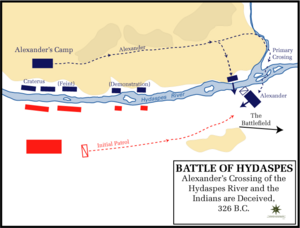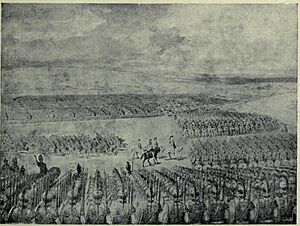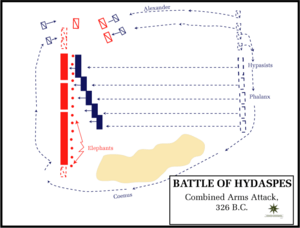Battle of the Hydaspes facts for kids
Quick facts for kids Battle of the Hydaspes |
|||||||||
|---|---|---|---|---|---|---|---|---|---|
| Part of Alexander's Indian campaign | |||||||||
 Alexander the Great and Porus Francesco Fontebasso |
|||||||||
|
|||||||||
| Belligerents | |||||||||
| Macedonian Empire Hellenic League Gandhara |
Pauravas | ||||||||
| Commanders and leaders | |||||||||
|
|
||||||||
| Strength | |||||||||
| 45,000–47,000 total
|
22,000–54,000 total
|
||||||||
| Casualties and losses | |||||||||
~1,000 total
|
21,000–23,000 total
|
||||||||
The Battle of the Hydaspes was a major fight between Alexander the Great and King Porus in May 326 BCE. It happened near the Hydaspes River in what is now Pakistan. This battle was part of Alexander's journey to conquer India.
Even though it was one of Alexander's toughest battles, his Macedonian army won a big victory. They captured King Porus, but Alexander was so impressed by Porus's bravery that he let him keep his kingdom. Alexander even made Porus a satrap, which means a local ruler.
This battle was very important in history. It brought Greek ideas and culture to the Indian subcontinent. This mix of cultures affected both Greeks and Indians for many years.
Contents
Why Did the Battle of the Hydaspes Happen?
After defeating his enemies in Persia in 328 BC, Alexander wanted to expand his empire even further into India. In 327 BC, he began his invasion by crossing the Khyber Pass. His army was very large, with about 40,000 foot soldiers and 5,000 horsemen.
Alexander faced strong resistance from local groups in the Hindu Kush mountains. But he still won, even when his army was greatly outnumbered.
In the spring of 326 BC, Alexander made a deal with Taxiles (also known as Ambhi), the King of Taxila. They joined forces against Taxiles's neighbor, King Porus of Hydaspes. Porus had refused to surrender to Alexander and was ready for war. Alexander needed to defeat Porus to continue his march east. Leaving a strong enemy behind him would have been too risky.
Porus chose a good place to defend his kingdom. Even though he lost, many historians believe he was Alexander's toughest opponent.
How Did Alexander Cross the River?
Alexander set up his camp on the north side of the Jhelum River (Hydaspes). King Porus waited on the south side, ready to stop any crossing. The river was deep and fast, making a direct attack very difficult.
Alexander knew he needed a clever plan. He moved his horsemen up and down the river each night. Porus's army followed him, trying to guess where he would cross.
Eventually, Alexander found a good spot about 27 kilometers (17 miles) upstream from his camp. There was an island in the middle of the river, hidden by trees. Alexander planned a surprise attack. He would cross the river with part of his army and attack Porus from the side.
He left his general, Craterus, with most of the army at the main camp. Craterus was told to cross and attack only if Porus moved his whole army to face Alexander. Alexander took about 6,000 foot soldiers and 5,000 horsemen with him. Other generals also prepared to cross at different points.
Alexander's crossing was a great achievement. He used many tricks to fool Porus. He made fake attempts to cross the river in different places. This kept Porus's army moving and guessing. Alexander even had a look-alike in a fake royal tent to make Porus think he was still at the main camp.
Alexander's troops crossed the river quietly, using boats made from animal skins filled with hay. A storm that night helped hide the sounds of their crossing. Alexander accidentally landed on an island first, but quickly crossed to the other side.
Porus realized what was happening and sent a small force of cavalry and chariots led by his son. But Alexander's horse archers and heavy cavalry quickly defeated them. Porus's chariots got stuck in the mud near the riverbank. Porus's son was killed.
When King Porus heard this, he knew Alexander had crossed. He rushed to face Alexander with his main army, leaving a small group behind to watch Craterus.
How Was the Battle Fought?

The two armies lined up for battle. Porus placed his war elephants in the center, about 50 feet apart. These huge animals were heavily armored and carried archers and javelin throwers in towers on their backs. Porus's soldiers wore colorful outfits and carried axes, spears, and maces. King Porus himself rode his tallest war elephant, wearing chain mail armor.
Alexander saw that Porus's center was very strong. So, he decided to attack the sides with his cavalry first. His foot soldiers (the phalanx) would wait until the Indian cavalry was dealt with. The Macedonian foot soldiers were outnumbered 1 to 5 by the Indian infantry. However, the Macedonians had better armor and longer spears called sarissas. The muddy ground made it hard for the Indian archers to aim well.
Alexander started the battle by sending his horse archers to bother the Indian cavalry on the right side. His strong Companion cavalry attacked the Indian cavalry on the left. Alexander himself led this charge. The rest of the Indian cavalry moved to help their friends, but Alexander's general, Coenus, attacked them from behind. The Indian horsemen got confused and were defeated by the Macedonian cavalry. They ran back to hide behind their elephants.
The war elephants then charged the Macedonian cavalry. These powerful beasts caused many losses for Alexander's foot soldiers. But the Macedonians fought bravely. Lightly armed soldiers threw spears at the elephants' riders and eyes. Heavy infantry tried to cut the elephants' legs with axes. Meanwhile, the Indian horsemen tried to attack again, but Alexander's cavalry pushed them back.
Eventually, the elephants turned around and ran back into their own lines. Many of their riders had been killed, so the panicked elephants trampled their own soldiers. Finally, the Macedonian foot soldiers locked their shields together and pushed forward. Alexander's cavalry charged from behind, trapping the Indian army. This was a "hammer and anvil" attack, crushing the Indian forces. At this moment, Craterus and his troops arrived, having finally crossed the river. They chased after the fleeing Indian soldiers.
What Happened After the Battle?

Alexander admired King Porus's bravery during the battle. He saw that Porus wanted to die fighting rather than be captured. Alexander wanted to save such a skilled leader. He sent his ally Taxiles to ask Porus to surrender. But Porus was so angry that he threw a spear at Taxiles!
Alexander sent more messengers, but Porus refused to listen. Finally, a friend of Porus named Meroes convinced him. Porus, tired and thirsty, got off his elephant and asked for water. After drinking, he allowed himself to be taken to Alexander. Alexander rode out to meet him, and their famous meeting took place.
Alexander asked Porus how he wished to be treated. Porus famously replied, "Treat me as a king would treat another king." Alexander was impressed and did just that. He allowed Porus to keep his lands and even gave him more territory.
Macedonian losses were around 1,000 soldiers killed. This was a high number for Alexander's army. Indian losses were much higher, with about 23,000 killed or captured. Two of Porus's sons were killed, along with many of his leaders. About 80 elephants were captured alive. Alexander also gained 70 more elephants from reinforcements that arrived too late for Porus.
After the battle, Alexander founded two cities. One was called Nikaia, meaning "Victory," at the battle site. The other was named Bucephala on the opposite river bank, honoring his loyal horse, Bucephalus, who died around this time.
Alexander's army wanted to go home after this battle. They were tired of fighting and worried about facing even bigger Indian armies. This happened at the Hyphasis River. Alexander agreed to turn back, but first, he marched his army south along the Indus River. He secured the riverbanks as the new borders of his empire.
Porus lost the battle because Alexander used clever tactics. The Macedonians also had better training and weapons. The Indian chariots were not as good as the Greek cavalry. The Indian soldiers also had less armor. However, Greek historians all agree that Porus fought very bravely until the end.
Later, during the Maurya Empire in India, a wise leader named Kautilya learned from the Battle of the Hydaspes. He stressed the importance of military training before battle. The first Mauryan emperor, Chandragupta, built a strong standing army. Chariots played a much smaller role in their military.
Images for kids
See also
- Seleucid–Mauryan war





